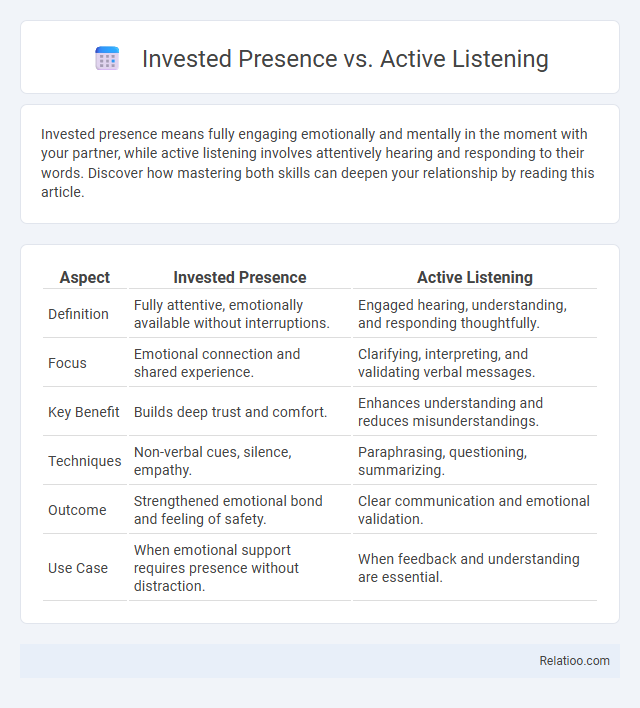Invested presence means fully engaging emotionally and mentally in the moment with your partner, while active listening involves attentively hearing and responding to their words. Discover how mastering both skills can deepen your relationship by reading this article.
Table of Comparison
| Aspect | Invested Presence | Active Listening |
|---|---|---|
| Definition | Fully attentive, emotionally available without interruptions. | Engaged hearing, understanding, and responding thoughtfully. |
| Focus | Emotional connection and shared experience. | Clarifying, interpreting, and validating verbal messages. |
| Key Benefit | Builds deep trust and comfort. | Enhances understanding and reduces misunderstandings. |
| Techniques | Non-verbal cues, silence, empathy. | Paraphrasing, questioning, summarizing. |
| Outcome | Strengthened emotional bond and feeling of safety. | Clear communication and emotional validation. |
| Use Case | When emotional support requires presence without distraction. | When feedback and understanding are essential. |
Understanding Invested Presence
Invested Presence involves fully engaging with the speaker by demonstrating genuine interest and emotional connection, surpassing the mere act of Active Listening, which focuses primarily on hearing and processing information. Unlike Active Listening, Invested Presence requires a conscious effort to be mentally and emotionally aligned with the speaker's message, fostering deeper mutual understanding and trust. This heightened level of engagement improves communication outcomes by ensuring that the listener not only comprehends the content but also resonates with the speaker's intentions and emotions.
Defining Active Listening
Active listening is a communication technique where your full attention is dedicated to understanding the speaker's message, emotions, and intent without interrupting. Unlike invested presence, which involves being physically and emotionally present, active listening requires deliberate mental engagement to decode both verbal and nonverbal cues. Mastering active listening enhances your relational skills by fostering trust, minimizing misunderstandings, and promoting meaningful dialogue.
Key Differences Between Invested Presence and Active Listening
Invested presence involves fully engaging with a person by being mentally and emotionally available, whereas active listening focuses on attentively hearing and processing the speaker's words through verbal and non-verbal feedback. Key differences include invested presence emphasizing emotional connection and mindfulness, while active listening prioritizes comprehension and response accuracy. Both skills enhance communication, but invested presence deepens relational trust, whereas active listening improves informational understanding.
The Psychology Behind Invested Presence
The psychology behind invested presence emphasizes deep cognitive and emotional engagement, fostering genuine connection and trust during interactions. Unlike active listening, which centers on hearing and processing verbal cues, invested presence involves full-body awareness and attunement to non-verbal signals, enhancing empathy and responsiveness. This holistic immersion amplifies social bonding and improves communication outcomes by aligning mental, emotional, and physical states.
Cognitive Benefits of Active Listening
Active listening enhances cognitive functions by improving attention, memory retention, and information processing, which surpasses the more passive engagement found in invested presence. While invested presence involves being mentally present during interactions, active listening requires deliberate effort to understand and respond, thereby strengthening neural pathways related to comprehension and critical thinking. You can leverage active listening techniques to boost cognitive benefits and foster deeper communication in both personal and professional contexts.
Practical Applications in Communication
Invested presence enhances communication by fostering genuine engagement through undivided attention and emotional attunement, leading to stronger connections and trust. Active listening emphasizes understanding and responding accurately by processing verbal and nonverbal cues, improving message clarity and reducing misunderstandings. Practical applications include combining invested presence with active listening techniques such as paraphrasing and asking open-ended questions to create meaningful dialogues in personal and professional settings.
Common Misconceptions About Listening
Invested presence involves fully engaging with the speaker's emotions and nonverbal cues, while active listening emphasizes understanding and responding to the content and intent of spoken words. Common misconceptions about listening include confusing mere silence or waiting to speak with genuine invested presence, which requires mindful attention beyond hearing words. Unlike passive hearing, effective listening demands conscious effort to interpret both verbal and nonverbal signals, fostering deeper empathy and clearer communication.
Cultivating Invested Presence in Conversations
Cultivating invested presence in conversations requires you to fully engage with the speaker, prioritizing their words and emotions beyond mere active listening. Unlike passive hearing or basic attentive behavior, invested presence involves intentional focus, empathy, and responsiveness that deepen connection and understanding. This practice enhances communication quality, builds trust, and fosters meaningful interactions essential for personal and professional relationships.
Techniques to Enhance Active Listening Skills
Invested Presence involves fully engaging with the speaker by maintaining eye contact, nodding, and using open body language to convey attention, while Active Listening emphasizes not just hearing words but understanding the underlying emotions and intent through reflective responses and summarization. Techniques to enhance Active Listening Skills include practicing mindful observation, asking clarifying questions, and minimizing distractions to keep Your focus intact throughout the conversation. Combining Invested Presence with Active Listening results in deeper connections and improved communication outcomes.
Choosing the Right Approach for Effective Relationships
Invested presence involves fully engaging in interactions by being mentally and emotionally available, enhancing trust and rapport in relationships. Active listening emphasizes attentively hearing and understanding the speaker's message, which prevents misunderstandings and fosters clear communication. Selecting the appropriate approach depends on the context and relationship goals, with invested presence nurturing deeper connections and active listening ensuring accurate information exchange.

Infographic: Invested Presence vs Active Listening
 relatioo.com
relatioo.com